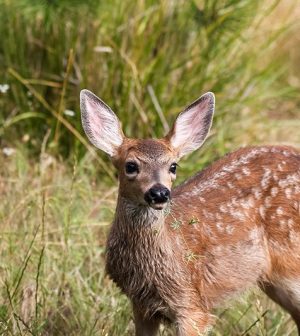- Skip Storing This Everyday Product in the Fridge Door
- Green Tea + B3 Pairing May Boost Brain Health
- Navigating Your Midlife Crisis: Embracing New Possibilities
- City Raccoons Showing Signs of Domestication
- Mapping the Exposome: Science Broadens Focus to Environmental Disease Triggers
- One Week Less on Social Media Linked to Better Mental Health
- Your Brain Changes in Stages as You Age, Study Finds
- Some Suicide Victims Show No Typical Warning Signs, Study Finds
- ByHeart Formula Faces Lawsuits After Babies Sickened With Botulism
- Switch to Vegan Diet Could Cut Your Greenhouse Gas Emissions in Half
Deer Can Shed Coronavirus for 5 Days After Infection

White-tailed deer can shed and transmit the COVID-19 virus for up to five days after they’re infected, according to a study that also identified where the virus develops and replicates in deer.
Five days is “a relatively short window of time in which the infected animals are shedding and are able to transmit the virus,” said co-author Dr. Diego Diel, director of the Cornell University Virology Laboratory in Ithaca, N.Y.
For the study, Diel and his team analyzed data from 2021 surveys of five U.S. states. Their findings were recently published in the journal PLOS Pathogens.
The researchers also found that the virus develops and replicates in the deer’s respiratory tract, lymphoid tissues (including tonsils and several lymph nodes) and in the central nervous system.
“Virus replication in the upper respiratory tract — especially the nasal turbinates [nose structures] — is comparable with what is observed in humans and in other animals that are susceptible to the infection, and I think that’s probably one of the reasons why the virus transmits so efficiently,” Diel said in a university news release.
As with humans, the virus spreads between deer through nasal and oral secretions and aerosols, he said.
The findings add to ongoing research investigating whether deer are reservoirs of SARS-CoV-2 in nature. Last year, scientists identified a number of cases in which the virus was transmitted from people into deer in several states.
And more recent research reported that the spread of a virus from animals to people and back again is not unique to COVID-19 and has occurred at least 100 times.
Pinpointing tissues in deer where the virus replicates during infection could be important for hunters, according to Diel’s team.
There is no evidence yet that people have caught COVID-19 from deer, but some experts are concerned hunters could get the virus from infected deer.
“Given the broad practice of deer hunting in the U.S., knowing the sites of virus replication is important to minimize the risks of exposure and transmission from these wild animals that could potentially transmit the virus back to humans,” Diel said.
More information
The U.S. Centers for Disease Control and Prevention has more on animals and COVID-19.
SOURCE: Cornell University, news release, March 22, 2022
Source: HealthDay
Copyright © 2025 HealthDay. All rights reserved.










